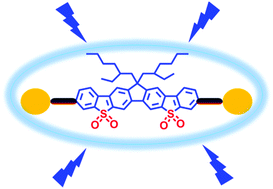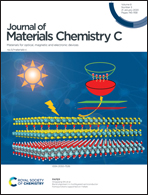Bis(benzothiophene-S,S-dioxide) fused small molecules realize solution-processible, high-performance and non-doped blue organic light-emitting diodes†
Abstract
The creation of new fluorescent cores plays an important role in developing high-performance blue organic light-emitting diode (OLED) materials. In this study, a series of novel bis(benzothiophene-S,S-dioxide) fused blue emitting molecules (FBTO-EHNa, FBTO-EHSF and FBTO-EHFF), which are symmetrically functionalized by naphthalene, spirobifluorene, and 9,9,9′,9′-tetraoctyl-9H,9′H-2,2′-difluoren, respectively, are designed and synthesized successfully. They possess high thermal stability, resulting from the largely fused polycyclic aromatic conformation and polar sulfonyl groups in the FBTO unit. Through incorporating the various electron-donating units, the π-conjugation length is effectively controlled, which exhibits a profound influence on the thermal, photophysical and electrochemical properties. Then, these three small molecules are characterized for solution-processible and non-doped OLEDs, in detail. All of them show typical blue emission from 456 to 470 nm in the electroluminescent devices. In particular, FBTO-EHFF outperforms both FBTO-EHNa and FBTO-EHSF by displaying a maximum current efficiency (CE) of 6.37 cd A−1 with a CIE coordinates of (0.20, 0.24). These results suggest that the rationally designed the bis(benzothiophene-S,S-dioxide) fused polycyclic molecules have great potential capability for achieving solution-processible, high-performance and stable blue OLEDs.

- This article is part of the themed collection: Journal of Materials Chemistry C HOT Papers


 Please wait while we load your content...
Please wait while we load your content...